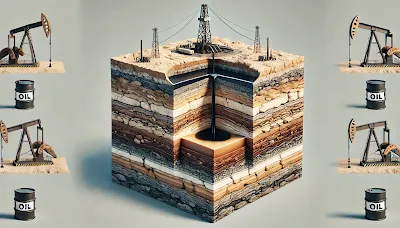Introduction: Unlocking the Next Wave of Oil Production
Oil fields worldwide have been extensively tapped for decades, yet a significant portion of crude remains trapped beneath the surface. Traditional extraction methods recover only about 30–40% of a reservoir’s original oil in place (OOIP), leaving a vast untapped potential. Enhanced Oil Recovery (EOR) techniques—often referred to as tertiary recovery—play a crucial role in maximizing production efficiency and extending the lifespan of mature fields.
EOR is increasingly vital as global demand for energy grows and easily accessible oil reserves become scarcer. According to the International Energy Agency (IEA), EOR technologies could unlock an additional 300 billion barrels of recoverable oil globally, significantly impacting future energy security. But how do these advanced methods work, and what does the future hold for EOR? Let’s explore the techniques, economic considerations, and environmental impact of enhanced oil recovery.
The Three Main Types of Enhanced Oil Recovery
1. Thermal EOR: Using Heat to Loosen Trapped Oil
Thermal recovery is one of the oldest and most widely used EOR methods. It involves the application of heat to reduce oil viscosity, making it easier to extract. The most common thermal EOR techniques include:
- Steam Injection: High-temperature steam is injected into the reservoir, heating the oil and allowing it to flow more freely.
- Cyclic Steam Stimulation (CSS): Also known as "huff and puff," this method involves alternating cycles of steam injection, soaking, and production from the same well.
- In-Situ Combustion: Air is injected into the reservoir to ignite a portion of the oil, generating heat that reduces the viscosity of surrounding crude.
Thermal EOR is particularly effective in heavy oil reservoirs, such as those in Canada’s oil sands and Venezuela’s Orinoco Belt. However, its high energy requirements and CO₂ emissions make it less environmentally friendly than other techniques.
2. Gas Injection: Leveraging Carbon Dioxide for Efficiency
Gas injection, particularly carbon dioxide (CO₂) injection, is among the most promising EOR techniques due to its dual benefits of increasing oil recovery and enabling carbon sequestration.
- CO₂ Injection: Supercritical CO₂ is injected into the reservoir, where it mixes with crude oil, reducing its viscosity and swelling the oil, making it easier to extract. This technique has been successfully deployed in major fields, including the Permian Basin in Texas, where CO₂-EOR contributes to nearly 20% of total oil production.
- Nitrogen and Hydrocarbon Gas Injection: In cases where CO₂ is unavailable, operators may use nitrogen or natural gas to maintain reservoir pressure and improve extraction.
A key advantage of CO₂-EOR is its ability to store CO₂ underground, contributing to carbon capture, utilization, and storage (CCUS) initiatives. With the growing focus on sustainability, many governments are incentivizing CO₂ injection projects to align with climate goals.
3. Chemical EOR: The Power of Surfactants and Polymers
Chemical EOR involves injecting specialized chemicals into the reservoir to improve oil recovery. These chemicals include:
- Surfactants: Detergent-like compounds that reduce oil-water interfacial tension, helping mobilize trapped oil.
- Polymers: Thickening agents that improve the sweeping efficiency of water floods by increasing its viscosity.
- Alkaline Solutions: Used to react with acidic crude oils, creating soap-like substances that enhance oil mobility.
Though highly effective, chemical EOR is often limited by cost and the challenge of chemical degradation in high-temperature or high-salinity reservoirs. Advances in nanotechnology and smart chemicals, however, are opening new doors for improved efficiency and cost-effectiveness.
Cost-Benefit Analysis: Is EOR Worth the Investment?
While EOR can significantly boost recovery rates—sometimes by 30% or more—it comes with substantial costs. On average, EOR projects cost between $10 and $40 per additional barrel of oil recovered, making them viable primarily when oil prices are above a certain threshold. However, advancements in technology and automation are helping reduce these costs.
Economic feasibility depends on several factors:
- Oil Prices: Higher crude prices justify the additional expense of EOR operations.
- Infrastructure Availability: Fields near existing CO₂ pipelines or steam generation facilities benefit from lower implementation costs.
- Regulatory Incentives: Governments worldwide are offering tax credits and subsidies for CO₂-EOR projects to promote lower-carbon production.
Future Trends in EOR: What’s Next?
1. Digital and AI-Driven Optimization
With the rise of big data and artificial intelligence (AI), operators are using advanced analytics to enhance EOR efficiency. Predictive modeling helps identify optimal injection patterns, reducing costs and improving recovery rates.
2. Low-Carbon EOR
As environmental regulations tighten, the industry is shifting toward low-carbon EOR solutions, including CO₂-EOR paired with direct air capture (DAC) to offset emissions.
3. Microbial EOR (MEOR)
Emerging research is exploring the use of microbes to alter oil properties, making it easier to extract. MEOR is still in its early stages but holds promise for eco-friendly oil recovery.
Case Study: The Revival of the Weyburn Oil Field
A compelling example of EOR’s success is the Weyburn Oil Field in Canada, where CO₂-EOR has been used since 2000. By injecting CO₂ captured from a coal gasification plant in North Dakota, operators have increased recovery by an estimated 130 million barrels while simultaneously storing millions of tons of CO₂ underground. The project has become a model for how EOR and CCUS can work hand-in-hand to support both energy production and carbon reduction.
Conclusion: The Role of EOR in a Sustainable Energy Future
Enhanced Oil Recovery is at the crossroads of economic opportunity and environmental responsibility. As the world seeks to balance energy security with carbon reduction, EOR—especially CO₂-based methods—will play a pivotal role in the industry’s transition. With continued technological advancements and policy support, EOR has the potential to not only extract billions of additional barrels of oil but also contribute to long-term sustainability goals.
As innovation continues, the oil fields of the future may look very different from those of the past. But one thing remains clear—enhanced oil recovery will be a key driver in the evolving landscape of global energy.

Comments
Post a Comment